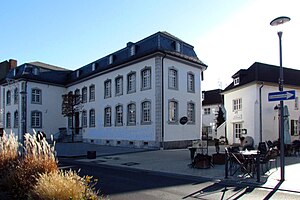Hünshoven oil mill
| Hünshoven oil mill
|
||
|---|---|---|
|
Hünshoven oil mill in the Hünshoven district |
||
| Location and history | ||
|
|
||
| Coordinates | 50 ° 57 '47 " N , 6 ° 7' 20" E | |
| Location | Germany | |
| Waters | little worm | |
| Built | 1380 | |
| Shut down | around 1953 | |
| technology | ||
| use | Oil mill | |
| Grinder | Pan mill and oil presses | |
| drive | Water wheel later turbine drive | |
| water wheel | undershot | |
The Hünshovener oil mill was a water mill with an undershot water wheel on the small worm in the city of Geilenkirchen in the North Rhine-Westphalian district of Heinsberg in the administrative district of Cologne .
geography
The Hünshovener oil mill had its location on the left side of the little worm, Adenauer at the Konrad street, in the district Hünshoven in the town of Geilenkirchen. The property on which the mill building stands today is approx. 73 m above sea level . As a mill on the small worm, it was also the neighboring mill of the Beeretz mill .
Waters
The mill was located on the so-called small worm, an artificially dug branch or engine channel centuries ago. 1/3 of the worm water was diverted from the worm and discharged again after passing the Hünshoven oil mill at the Geilenkirchen bridge.
The worm supplied numerous mills with water over a river length of 53 km. The source of the worm is south of Aachen at 265 m above sea level. The confluence with the Rur is in the town of Kempen in the town of Heinsberg at 32 m above sea level. In the late 1960s and early 1970s, worm straightening was carried out. The curving, now and then meandering course of the river disappeared in favor of a simple route . The river length shortened and the flow speed increased. For many people the flood protection improved , for the mills it was the end. The water association Eifel-Rur (WVER) is responsible for the care and maintenance of the water body with a catchment area of 355.518 km 2 .
history
The Hünshovener mill was born on November 24, 1380. On this day, the married couple Heinrich and Katharina Coenen from Geilenkirchen received permission from the Heinsberg lords to build an oil mill near the worm bridge. The annual delivery of 55 quarts (about 60 liters) of oil was to be delivered to the court chamber . As of 1539, it is known that the annual oil delivery in a Kellnerei - invoice was entered in a book. In 1559 the owners of the mill were named in the detailed entry. The entry translated into standard German reads:
- Heinrich Coenen, son of Geilenkirchen and his housewife Catharina and their heirs, was granted the privilege of building the oil mill in Hünshoven on the evening of St. Catharines in 1380 by Goddart von Loen, Mr. zu Heinsberg, and Mrs. Philippa von Jülich To keep it, to deliver 55 quarts of Geilenkirchener Maß good, clear oil annually at Shrovetide, which should be paid for Palm Sunday, with the proviso that if the tenants fail to pay some or all of the payment within the predetermined time, then the Mill with the house and yard next to it, with all improvements, is said to have expired as a pledge. So I received 55 quart from the current owner of the aforementioned mill, Gerhard Engelen and his brother-in-law Gyssen van Dremmen
The mill developed from a small business to a strong commercial enterprise over the centuries . The unrivaled mill worked with pan mill and impact presses until 1920 . Then they switched to hydraulic oil presses and water turbines . In World War II Geilenkirchen has been completely evacuated . The oil mill was badly damaged by bombs and grenades . After the reconstruction, oil production was resumed in 1949. In the difficult economic post-war period , the company ran into financial difficulties in 1953 and stopped production . This is how the history of the Hünshoven oil mill ended after 573 years .
gallery
Worm and branch canal on the Tranchot map 1805/1807
Monument entry
House Basten: Year of construction: 18th century; four-wing brick courtyard, two-storey residential building in eight to two axes, on the left risalit two to one axes, brick, white puddled; Base, stairs, corners and walls in bluestone, mansard roof. Entry in the list of monuments on March 29, 1983
literature
- Hans Vogt: Lower Rhine water mill guide 2nd edition. Verein Niederrhein, Krefeld 1998, ISBN 3-00-002906-0 , pages 290
- Hans-Josef Sprünken: Geilenkirchens Mühlen an der Wurm home calendar of the Heinsberg district, 1992, pages 35–42
- Herbert Fluss: Contributions to the history of the Hünshovener Oelmühle home calendar of the Selfkantkreis Geilenkirchen-Heinsberg, 1959, page 37 ff, with continuations up to 1967.
→ See also the list of mills on the Wurm
Web links
Individual evidence
- ^ German basic map 1: 5000
- ↑ Topographical Information Management, Cologne District Government, Department GEObasis NRW ( Notes )
- ↑ Archive link ( Memento from October 17, 2013 in the Internet Archive )
- ↑ http://www.wver.de/







